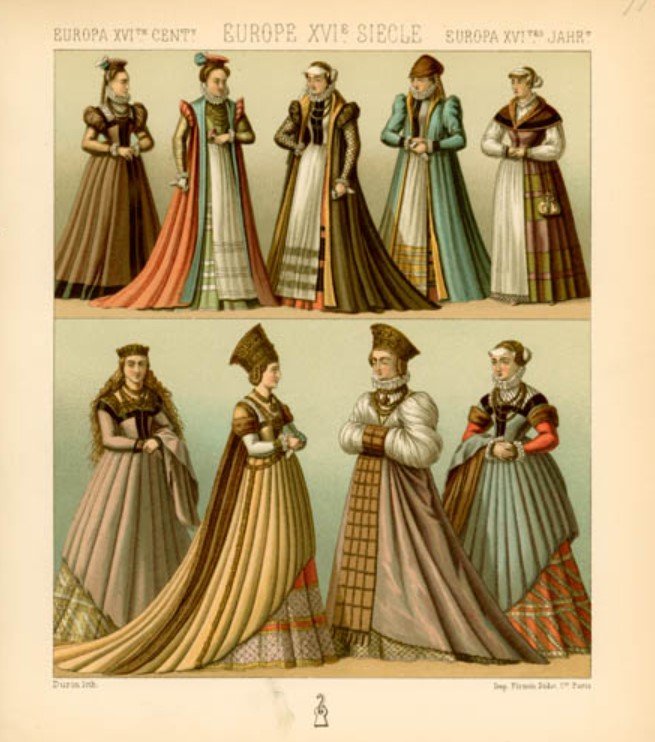Fashion in the 16th century was a dynamic and vibrant expression of cultural and social changes. In Germany, this period marked a time of significant transition, where fashion not only reflected status and wealth but also the shifting tides of political and religious landscapes. As a fashion content creator, exploring this fascinating 16th century German fashion era offers a unique glimpse into the rich tapestry of history and style. Let’s delve into the key elements that defined German fashion in the 16th century.
The Renaissance Influence
The Renaissance brought a wave of new ideas and cultural rebirth across Europe, significantly impacting German fashion. Influences from Italian and Spanish styles began to merge with traditional German clothing, creating a unique blend that characterized the era.
Key Elements:
- Slashing and Puffing: This technique involved cutting the outer fabric to reveal contrasting colors of the underlayer, creating a striking visual effect. It was prevalent in both men’s and women’s clothing.
- Embroidery: Elaborate embroidery became a symbol of wealth and status. Garments were adorned with intricate patterns, often featuring floral and geometric designs.
- Rich Fabrics: Silk, velvet, and brocade were popular choices among the wealthy. These luxurious materials showcased the wearer’s affluence and taste.

Men’s Fashion
Men’s fashion in the 16th century was characterized by its bold and robust style. The garments were designed to emphasize a strong, masculine silhouette.
Key Elements:
- Doublets and Hose: The doublet, a snug-fitting jacket, was a staple of men’s fashion. It was often paired with hose, tight-fitting trousers that extended to the knee.
- Codpieces: These exaggerated pouches attached to the front of the hose were both functional and symbolic, representing virility and status.
- Capes and Cloaks: Capes and cloaks added an element of grandeur and were often lined with fur for warmth and luxury.

Women’s Fashion
Women’s fashion during this period was equally elaborate, focusing on creating a graceful and imposing figure.
Key Elements:
- Gowns: Gowns with fitted bodices and voluminous skirts were the mainstay of women’s fashion. These gowns often featured detachable sleeves that allowed for versatility.
- Corsets and Farthingales: Corsets were used to shape the torso into a desired silhouette, while farthingales, or hooped skirts, added volume to the skirts, emphasizing a narrow waist.
- Headgear: Headdresses and veils were essential accessories. The wulsthaube, a padded cap, was popular among married women, often adorned with veils and jewels.

Regional Variations
While these elements were common, regional variations added diversity to German fashion. The northern regions, influenced by the Hanseatic League’s trade connections, had different styles compared to the southern regions, which were more influenced by Italian fashion.
Examples:
- Northern Germany: Clothing was more subdued in color and decoration, reflecting the influence of the Protestant Reformation.
- Southern Germany: More vibrant colors and elaborate designs were prevalent, influenced by Catholic traditions and Italian fashion.

Opposing Viewpoints
Despite the opulence of 16th century fashion, it was not without its critics. Some viewed the extravagant styles as a sign of moral decay and vanity, particularly during the Protestant Reformation. Leaders like Martin Luther condemned the excessive display of wealth and advocated for simpler, more modest attire.
Conclusion
16th century German fashion is a testament to the cultural and social currents of its time. It was a period of innovation and grandeur, where clothing was not just about covering the body but making a statement. From the intricate slashing and puffing techniques to the robust doublets and elegant gowns, every garment told a story. By understanding these historical fashions, we gain insight into the values, beliefs, and lifestyles of the people who wore them.
As a fashion content creator, delving into such rich historical contexts not only broadens our perspective but also enriches our understanding of modern fashion trends. By examining the past, we can better appreciate the evolution of style and the ever-changing nature of fashion.





